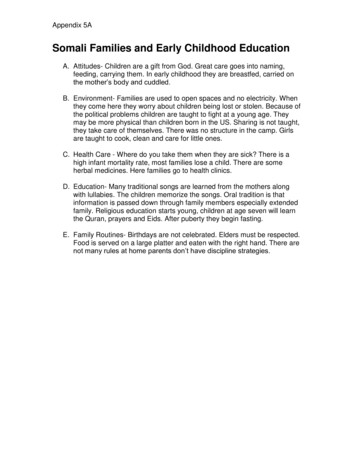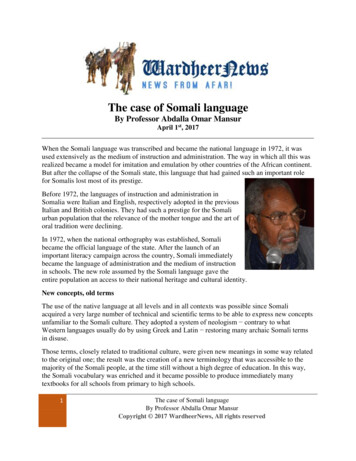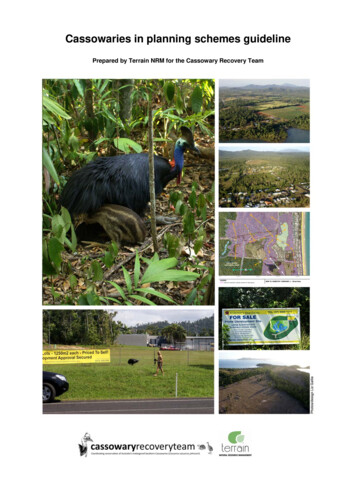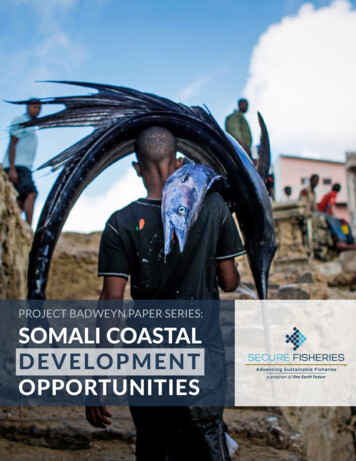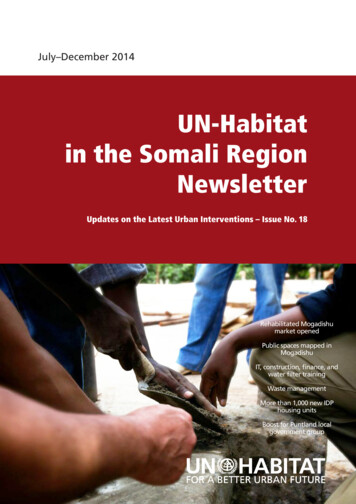
Transcription
July–December 2014UN-Habitatin the Somali RegionNewsletterUpdates on the Latest Urban Interventions – Issue No. 18Rehabilitated Mogadishumarket openedPublic spaces mapped inMogadishuIT, construction, finance, andwater filter trainingWaste managementMore than 1,000 new IDPhousing unitsBoost for Puntland localgovernment group1
Crucial waste management enhanced inBoroma, Berbera, and HargeisaWaste ManagementSomaliland, which suffered devastation during the civil war, is trekking back to normalcy due to its internalresilience. Donor agencies are assisting it on this journey, and UN-Habitat has been supporting some criticaldevelopment areas to enable Somaliland to regain its past glory.The country severely lacks basic infrastructure for solid waste and biomedical waste management. The majorityof citizens throw their domestic and trade- and industry-related waste on the street, and health-care institutionsdo not have any facilities for biomedical waste management. Both kinds of waste are partially collected, buteven that which ends up at the open dumping sites poses a serious threat to public health and the environment.With a view to helping local governments improve their solid waste management systems and helping healthcare institutions improve biomedical waste management, UN-Habitat (through the UN Joint Programme on LocalGovernance and Decentralized Service Delivery) is providing technical assistance to enhance these services anddevelop municipal by-laws to regulate waste management. The agency is undertaking pilot projects for municipalsolid waste management in Boroma and Berbera, and for biomedical waste management in Hargeisa, Boroma,and Berbera. The projects will demonstrate that the improvements can be replicated.An international consultant has been hired, and standard by-laws have been duly prepared and shared withthe local authorities of nine major cities. The modalities for the implementation of the pilot projects have beenworked out, in consultation with the local governments, and a service delivery model and implementationstrategy have been finalized. To enable implementation, financial support will be given to the pilot cities for theprocurement of tools, equipment, and vehicles.Emrah Engindeniz,Human Settlements OfficerMunicipal staff at a meeting to discuss waste management services and by-laws.2
What’s New!SomalilandNew city hall for BerberaBerbera has an impressive new city hall on its skyline. Resulting from an agreement betweenthe Berbera local government and UN-Habitat (under the UN Joint Programme on LocalGovernance and Decentralized Service Delivery), the construction project aimed to decongestthe old municipality building by providing a larger meeting hall and additional office spacefor various public services. The new city hall was planned as a two-storey building, with theoffices on the ground floor and the meeting hall on the second floor. A third floor was lateradded, paid for by Berbera Municipality. See the full story on page 8.South central SomaliaConstruction workers, foremen, and supervisors trained in MogadishuIn September and October, for the first time ever, the Benadir Regional Administration Training Department and the Urban HeritageCentre conducted construction training courses. Based on the SECIL reference manual, which is now available in Somali, the programmedeveloped two short-term training courses for (i) construction workers and (ii) supervisors and foremen. The former focuses onpractical exercises and best building practices, while the latter concentrates on how to efficiently plan and manage a constructionsite, construction materials, and a labour force. There are currently 4 training courses being held for supervisors and 9 trainings beingheld for workers, with 193 supervisors and 184 workers trained to date. The demand for the course for supervisors and foremen isconstantly increasing, as local universities have expressed an interest in sending students who are in their fourth and final year of study.PuntlandLocal government body visits ArushaIn August and September, UN-Habitat and the UN Joint Programme on Local Governance andDecentralized Service Delivery (JPLG) facilitated an exposure visit by mayors from Puntlandtowns and directors from the Puntland Ministry of Interior to Arusha, Tanzania. The delegationwas hosted by the East African Local Governments Association. Local government authoritiesin Puntland formed their own association in 2009, called the Association of Local GovernmentAuthorities of Puntland, after which UN-Habitat and JPLG sought partnerships for them inthe region. During the Arusha visit, the various groups were able to discuss crucial issuesand share their experiences and lessons learned. See the full story on page 9.South central SomaliaSomalia delegation participates in World Water Week, StockholmIn order to foster positive and constructive dialogue among actors at the local and federal level and to further reinforce theircapacity to establish frameworks for water regulation, SECIL supported the attendance of a Somali delegation at World WaterWeek in Stockholm (31 August to 5 September). Members of the group were from the Ministry of Energy and Water Resources,the Benadir Regional Administration, and the Somalia Country Water Partnership. In addition to presenting the challenges facingMogadishu’s water system at this global forum, the attendees were able to hear from other international delegates about theirpositive experiences with integrated water resource management and energy in the development context. By joining this globalwater partnership, the delegation has started building networks and cultivating a new, more resilient vision for the future ofSomalia’s water and energy sectors.3
New settlement projects provide 1,310housing units to over 7,800 internallydisplaced peopleIDP SettlementsUnder UN-Habitat’s Shelter Programme, with funding provided by the Government of Japan, an additional 1,310low-cost housing units are being constructed for internally displaced persons (IDPs) and returnees in 2014 and2015 in Somaliland and Puntland. The new projects are focused on five towns and are a continuation of previousUN-Habitat projects, under which over 3,000 permanent housing units have been built for IDPs since 2008.The interventions carried out under the new funding respond to UN-Habitat’s mandate to ‘build back communities’in a post-conflict situation and also respond to the continuous need to provide durable solutions for thereintegration and resettlement of displaced communities. The project goal is to create improved living conditionsfor displaced communities in four towns in Somaliland (Hargeisa, Boroma, Burao, and Berbera) and a key townin Puntland (Bossaso), through the provision of durable shelter, basic water and sanitation, and skills trainingfor increased livelihood opportunities.The site selection for the resettlement of IDPs and returnees is based on the availability of land, which is beingprovided for free by local governments and in negotiation with private landowners. Public urban land in Somaliais not easily available. Municipalities have therefore moved towards a practice of reclaiming land for public useby transferring privately owned rural land to urban land titles. UN-Habitat has criteria for excluding sites that arenot suitable for permanent settlement: for example, the lack of land ownership transparency, security, transport,livelihoods, and access to water. The resettlement land is being planned together with access roads and spacefor community facilities.Community infrastructurePublic community infrastructure – a community centre, a small school, a health centre – will benefit both IDPs/returnees and the host community. These subprojects will be selected jointly through public consultations withthe host and beneficiary communities at each location.Skills training for livelihood developmentIn addition to providing low-cost shelter and sanitation, the project improves the livelihood situation of thebeneficiaries by providing basic skills training in income-generating activities (prioritized by the communitiesthemselves). The project anticipates a range of possible areas: tailoring, cloth making, beauty care, catering,information technology, plumbing, electricity, and carpentry. A consultation process has selected 165 male andfemale participants for the skills training.Anna Sobczak,Associate Human Settlements OfficerInternally displaced persons in SomaliaSomalia has generally been in a state of pseudo-anarchy, ruled by warlords and clan leaders, followingthe collapse of the Siad Barre regime in 1991. During the early years of the war, the self-declared Republicof Somaliland – particularly its capital city Hargeisa, the second-largest town Burao, and the strategicport city of Berbera – suffered heavy attacks by forces from southern Somalia. Large portions of thepopulation fled to neighbouring Ethiopia and Djibouti, or sought protection elsewhere.Ironically, the ongoing armed conflict and faltering attempts to establish governance and rule of lawin the south contributed to the gradual stabilization of the northern regions. The relative stability ofthe northern regions acted like a magnet for IDPs from the south as well as those from rural areas allover Somalia, whose economies were ravaged by recurrent drought, environmental degradation, andblocked access to markets.The UN estimates that there are still close to 1.1 million IDPs in Somalia today, representing close to 15percent of the total population. These are chronically vulnerable people who lack even the most basicprotection and essential services. Living conditions are among the worst in Africa, and poverty levels areextremely high. Most returnees and IDPs are ‘long-term’ displaced people. They have settled for manyyears in vacant spaces and at the fringes of urban centres with very limited livelihood opportunities,little access to basic services and education, and no appropriate or durable housing.4
Top left: The ‘Ayaha 4’housing settlement inHargeisa, completed in2014.Top right: Architecturalmodel of the housing unitdesign for Hargeisa.Middle left: Plan for the settlementproject in Hargeisa.Middle right: Plans for Hargeisa andBoroma on Google Earth images.Bottom left: Layout plan for theBurao settlement project.Bottom right: Site visit forinterested contractors in Hargeisain September.5
Computer training comes to HargeisaCapacity DevelopmentBetween June and August 2014, the Somaliland National Information and Computing Technology (ICT) Commissionimplemented a computer training course for 70 participants from 7 local governments – Burao, Hargesia, Gabiley, Berbera,Sheikh, Odweine, and Boroma – as well as the Auditor-General’s Office and the Ministry of Interior. The participantswere training in basic computer usage, including Microsoft Office applications, the Internet, computer troubleshooting,AIMS and BIMS accounting software, computer hardware, and networking.This training was in line with the Somaliland National Development Plan (2012–2016), through which UN-Habitat isdeveloping the information technology skills of local government staff. The purpose of the training is to update employeesabout the latest developments in technology, allowing them to get the maximum value out of their software applications.The training course was opened by the Somaliland National ICT Commission Chairman Eng. Ali Abdullah Tahir, whoinformed the participants about the benefits of the training and how the technology helps to increase efficiency,productivity, and capabilities. Asha Mohamed, representing UN-Habitat, discussed the positive collaboration amongthe UN Joint Programme on Local Governance and Decentralized Service Delivery, UN-Habitat, and the ICT commission.The training was done over 28 days, in two sessions of 14 days each, and utilized lectures, demonstrations, groupdiscussions, labs, and practical sessions. An evaluation at the end of the course found that 84 percent of the participantswere happy with it, as it provided the ability to improve their work performance – now that they are able to operate thesoftware applications they were trained on – and also gave a fuller understanding of the various applications availableon their computers.During the closing ceremonies of the two sessions, the participants were awarded Certificates of Participation by theDirector of Peace and Security and the Director of Districts from the Ministry of Interior.Garowe hosts finance and accounting trainingIn May and June 2014, the UN Joint Programme on Local Governance and Decentralized Service Delivery (JPLG) andUN-Habitat conducted finance and accounting training workshops for municipality staff and mayors. The main objectiveof the finance training was to train 80 employees and 7 mayors and executive secretaries from Bossaso, Gardho, Bayla,Eyl, Jariiban, Garowe, and Galkayo in finance. The training aimed to effectively increase the knowledge of mayors andcouncil staff regarding their duties and responsibilities in promoting accountability and transparency in financial matters.The planned training outcomes were as follows: To improve the basic understanding of accounting principles To understand reports relevant to their work To learn how to interpret the relevant reports To appreciate public–private partnerships as a means for delivering services To understand governance, risk, and ethical issuesThe training was delivered through lectures, group discussions, demonstrations, and role plays, using real world examplesfrom the participants. The training curriculum was based on the Association of Chartered Certified Accountantscurriculum. The subjects covered included Introduction to Accounting, Financial Accounting, Management Accounting,Financial Reporting, Government Taxation, Introduction to International Public Sector Accounting Standards, Public–Private Partnerships, and Procurement.Puntland State University, one of the leading universities in the Puntland State region, did the training, which was donein three different sessions. The first session was designed for participants with university education or many years ofexperience in the accounting profession. It was opened by Osman Mohamed Osman from UN-Habitat and the headof the Ministry of Interior’s Department of Local Government, Mr. Jama.The second session was designed for students with no accounting experience or training – this session was 14 days. Thethird session was designed for mayors and executives from the different districts and was done over a period of fourdays. The participants were given a brief overview on the topics their staff had already covered, and emphasis was placedon the importance of accounting and reporting, as well as the interpretation of reports produced by accounting staff.The final training workshop was officially closed by the vice-minister of the Ministry of Interior. UN-Habitat was representedby Osman Mohamed Osman, and JPLG was represented by the local team leader, Ahmed Said.6James Mugambi,Information Technology Officer
Biosand water filter training for MogadishuAmong the myriad challenges Mogadishu faces are the considerable deficits that exist in the basic infrastructure of many ofits key institutions. Crucially, this extends to the provision of clean, safe drinking water for the people, forcing a large shareof Mogadishu’s population to rely on uncontrolled, low-quality shallow wells for their water supply.It was with the aim of assisting low-income populations to access clean drinking water that, through SECIL, a Kenyan NGOcalled Pillar for Maasai Development trained potential biosand water filter producers in Somalia. Biosand technology consistsof several carefully prepared layers of sand and gravel, through which water is filtered. The small size and adaptability of theproduct for intermittent use makes it suitable for households.An initial training for the local producers was held in Kenya during April and May 2014 for the purpose of building theircapacity and technical expertise. They would thereby be able to both produce biosand water filters and facilitate the trainingof other local producers in Mogadishu. In addition to production techniques, participants were taught how to create businessplans. They were also taught marketing strategies that stimulate the consumer market for clean, inexpensive drinking water.A subsequent training was held in Mogadishu over a five-day period in September 2014 for a larger group of biosandfilter producers. The most motivated of these local producers were then selected and furnished with additional tools andequipment to commence biosand filter production on a larger scale for consumption by local households. Follow-up andessential marketing support will be provided to introduce this useful product to the Somali people more widely.Bruno Le Bansais,SECIL Water ConsultantAbove: Biosandfilter training byPillar for MaasaiDevelopment.Left: Participantsin the computertraining coursein Hargeisa, aftercompletion of thecourse.7
Berbera’s new city hall risesBerbera, Somaliland, has a new city hall on its skyline. Resulting from an agreement between the Berbera localgovernment and UN-Habitat (under the UN Joint Programme on Local Governance and Decentralized Service Delivery),the construction project aimed to decongest the old municipality building by providing a larger meeting hall andadditional office space for various public services.The new city hall was planned as a two-storey building, with the offices on the ground floor and the meeting hall onthe second floor. Following a tendering process, Berbera Municipality awarded the construction contract to TawfiiqConstruction Company. The actual construction work started in May 2013, under a newly elected local governmentadministration. The new mayor and his councillors strongly expressed the need for an additional floor. Though UNHabitat was unable at that stage to provide additional funds, it offered technical support for this upgrading.Local Governance and InfrastructureLocated near the existing local government compound, the new three-storey building was completed in July 2014.As the area is close to sea level, the construction took care to protect against salt water infiltration. The original twostorey project cost USD 41,000; the costs related to adding the third floor, which required significant modification andreinforcement, were willingly covered by Berbera Municipality.Paolo Pompili,Project ManagerThe new city hall building in Berbera, at different stages in its construction.Ansalooti Market officially openedAs part of reviving Mogadishu’s vibrant economy, SECIL identified the rehabilitation of markets as key projectsthat have the potential to stimulate economic growth in the region and increase employment opportunities forsurrounding communities. Located in the central Hamarjajab District, the historically significant Ansalooti Market wasa hub of economic activity for 55 years, functioning as a central place for individuals to purchase their daily food,including meat, vegetables, and fish. Following the civil war, the market became yet another dilapidated buildingin Mogadishu’s cityscape.Construction related to Ansalooti’s rehabilitation commenced in March. The action hopes to restore this market to thevibrant economic hub it once was and, more importantly, to offer vendors in the local and surrounding communitiesan opportunity to earn a living.The official opening of the market was held on 13 September 2014 and was attended by Deputy Mayor MohamedAden Guled along with several District Commissioners, including Ahmed Dhore, the DC of Hamarjajab. With 100stalls inside the market and another 100 outside, vendors are already busy, benefiting from a cleaner and healthierenvironment in which to sell their goods.Falastin Omar,SECIL Programme Support Officer8
New offices for Puntland local government bodyA groundbreaking ceremony for the office facilities of the Association of Local Government Authorities of Puntland (ALGAPL)was held in Garowe on 27 October. The land for the new offices was made available by Garowe Municipality, and the projectis being funded by UN-Habitat through the UN Joint Programme on Local Governance and Decentralized Service Delivery(JPLG). A conference hall will be among the new structures.The Vice-President of Puntland, Abdulhakim Abdullahi Haji Omar, presided over the ceremony. Other government dignitariesincluded the Deputy Minister of Interior and the ALGAPL secretariat. Representatives from UN-Habitat and JPLG also attended.Abdi Aziz Noor Elmi, the Mayor of Garowe and Chairman of ALGAPL, briefly discussed the history of the association and notedits vision of having a strong and united group that represents the best interests of local governments in Puntland. He thankedUN-Habitat/JPLG for being a long-term ally and reliable partner and welcomed their ongoing support in institutionalizingALGAPL.Towards the end of the ceremony, after others had spoken, Vice-President Abdulhakim Abdullahi Haji Omar laid the foundationstone. He said that he hoped that the association will contribute to the democratization process that the Puntland State ofSomalia had embraced, and also praised the work of UN-Habitat and JPLG in Puntland.Abdirahman Adan Mohamoud,National Programme OfficerLeft: The Vice-President of Puntland with the Deputy Minister of Interior at the groundbreaking. Right: Participants at the ALGAPL workshop in Arusha.Local government association visits ArushaIn late August and early September, UN-Habitat and the UN Joint Programme on Local Governance and Decentralized ServiceDelivery (JPLG) facilitated an exposure visit by mayors from Puntland towns and directors from the Puntland Ministry of Interiorto Arusha, Tanzania. The delegation was hosted by the East African Local Governments Association, an umbrella organizationmade up of various national associations of local governments – Burundi, Tanzania, Kenya, Rwanda, and Uganda. The regionalassociation has its headquarters in Arusha.Local government authorities in Puntland formed their own association in 2009, called the Association of Local GovernmentAuthorities of Puntland (ALGAPL). Given the need to support this nascent association, UN-Habitat and JPLG sought partnershipsin the region. During the Arusha visit, the various groups were able to discuss crucial issues and share their experiencesand lessons learned. The Association of Local Authorities of Tanzania played a key role in the workshop. In addition to thediscussions, the mayors from Puntland met the deputy mayor of Arusha and visited selected projects, including solid andliquid waste management facilities, markets, a public health centre, and a community centre.This visit was timely, as it came after the approval of a decentralization policy by the council of ministers in Puntland. Underthe new system, some subnational structures will be responsible for delivering certain services. The delegation’s exposure toregional local governance issues and best practices will be of great value, despite the financial and human resource challengesin Puntland.A number of local government authorities have joined ALGAPL since 2009, but it is expected to attract more districts.The association advocates the interests of local governments and aims to create an enabling environment for subnationalstructures. It also works towards improving local governance in general and devolving some central government functionsand resources for better service delivery.Abdirahman Adan Mohamoud,National Programme Officer9
Mapping public spaces and upgrading thepublic space around Sinay MarketUrban Development and Employment CreationBackgroundFollowing 20 years of civil war, much of Mogadishu’s economic infrastructure has been either destroyed or severelydamaged. Public urban space is both limited and contested; land ownership is a dominant and controversialissue and continues to hinder the development of basic urban services and infrastructure. Land which doesremain free and uncontested is generally undeveloped or is dilapidated or misused as a result of conflict andpoor maintenance. This situation in turn results from insufficient political will, limited financial and technicalresources, and unclear responsibilities among the various stakeholders.The absence of adequate urban public spaces has had adverse effects on city dwellers’ quality of life and theireconomic and social well-being. Citizens are deprived of space for recreation, mobility, and commercial exchange.This has substantial negative impacts, not only on individual well-being but also more broadly on social cohesion,cooperation, development, and peace.Such negative social impacts are further accentuated by a general lack of employment and livelihood prospects.Civil strife has severely eroded the livelihood asset base of the Somali people. Urban populations in Somalialargely rely on an informal economy based on trade, subsistence, and micro, small, and medium-sized enterprises.Under the project titled Upgrading Public Space and Increasing Employment Opportunities in Warta Nabada, Mogadishu,UN-Habitat Somalia (with co-funding from the UN-Habitat Urban Planning and Design Branch) seeks to improve thequality of urban life and increase employment opportunities through rehabilitated public spaces and improved, moresecure market and trading facilities in Mogadishu.Under the economic infrastructure component of the SECIL project, the main Sinay Market building is due to be rehabilitatedin February 2015. However, with a large surrounding area that has huge potential for contributing to economic growth,additional rehabilitation and development is needed. The Urban Planning and Design Branch funds will support this work.UN-Habitat Somalia and the Benadir Regional Administration (BRA) Department of Urban Planning are jointly planningthe activities.The aim of this rehabilitation is to turn the area into an economic hub for the district as well as a central area for communitymeetings, gatherings, and events. The rehabilitation shall stimulate and maximize economic activity. The new plan willincorporate the existing vendors’ society to ensure their ownership of the project. Upgrading and enhancing the diversityand utility of the wider market area will contribute to local development, the local economy, and increased social capitaland peace in the area.As part of the project, the capacities of the BRA and its Department of Urban Planning are being strengthened throughtechnical trainings such as the completed Urban Planning Basics and Public Space Planning workshop and an upcomingintense course on geographic information system (GIS) mapping.Using its acquired skills, the BRA Department of Urban Planning planned and organized a participatory, multi-stakeholdercommunity planning workshop in August 2014 to establish users’ needs and priorities with regard to urban public space,with a focus on the Sinay Market rehabilitation. Based on this event, a final draft plan for the integration of infrastructureelements around Sinay Market has been prepared. It considers existing and newly required spatial elements: existingpathways, needed access roads, garbage dumps that must be removed, and existing market stalls that will be incorporated.Based on the above participatory planning, design, and budgeting process, UN-Habitat prepared the design for thenew Sinay Market hall, which will be financed by the SECIL project and incorporated into the wider layout of the SinayMarket area.Citywide mapThe project is also developing a citywide map of the current public spaces in Mogadishu; this will be the core buildingblock for the larger-scale protection and development of Mogadishu’s public spaces. The map can be used as a strategicplanning tool for allocation, connection, and network planning. Most importantly, the map can serve as the planningand coordination basis for steering investments towards the rehabilitation of public spaces across the city.10Anna Sobczak,Associate Human Settlements Officer
Top right: Conceptualproposal by UN-Habitatused for the localconsultation workshop forthe Sinay Market area.Top left: The SinayMarket area rehabilitationproposal prepared byBRA DUP based on thecommunity workshop.Middle left: The firstmap visualizations of theGPS data collected onMogadishu public spacesby the BRA DUP, withtechnical support fromUN-Habitat Somalia.Middle inset: The DUPteam during the UrbanPlanning Basics and PublicSpace Planning workshop.Bottom: Four photos ofSinay Market.11
UN-Habitat donors and funding agenciesDanish International DANIDA funds the UN Joint Programme on Local Governance andDevelopment Agency Decentralized Service Delivery.European The EC is the main donor of UN-Habitat operations in the Somali region.Commission The commission provides funding and technical and strategic guidance toprogramme design and implementation. The EC is an important donor to theUN Joint Programme on Local Governance and Decentralized ServiceDelivery, and funds the Sustainable Employment Creation and ImprovedLivelihoods for Vulnerable Urban Communities in Mogadishu (SECIL) Project,while the Hargeisa Urban Water Supply Upgrading Project is the largestEC-supported intervention by UN-Habitat worldwide.Government of Italy The support of the Government of Italy, often through Italian Cooperation,has been consistent throughout UN-Habitat’s presence in the Somali region.It funds shelter, rehabilitation, and service delivery programmes, and fundsthe UN Joint Programme on Local Governance and DecentralizedService Delivery.UN-Habitat contacts:UN-HabitatRegional Office for AfricaAxumite abitat.orgUN-HabitatOffice for the Somali RegionDragan TaticGovernment of Japan The Government of Japan funds durable shelt
AIMS and BIMS accounting software, computer hardware, and networking. This training was in line with the Somaliland National Development Plan (2012-2016), through which UN-Habitat is developing the information technology skills of local government staff. The purpose of the training is to update employees



